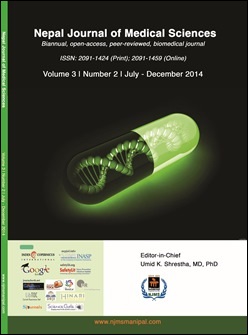Non fermentative gram negative bacilli as nosocomial pathogens: Identification and antibiotic sensitivity in clinical samples of indoor patients
DOI:
https://doi.org/10.3126/njms.v3i2.13452Keywords:
Hospital acquired infections, multi drug resistance, non fermenting gram negative bacilliAbstract
Background: Non fermenting gram negative bacilli (NFGNB) are usually considered to be non pathogenic commensals of little significance, however, data suggest that they are remarkable because of antimicrobial resistance; propensity to cause outbreaks and complex epidemiology. This study was conducted to find out the prevalence and sensitivity pattern of NFGNB from various clinical samples.
Methods: A total of 519 samples were received from patients suspected of having hospital acquired infections (HAI), admitted in Sawai Man Singh Hospital, Jaipur, India. Organisms grown on culture were subjected to phenotypic identification along with antimicrobial sensitivity testing by Kirby Bauer’s disc diffusion method.
Results: Among 366 culture positive samples, 94 (25.6%) NFGNB were isolated. Maximum pevalence prevalence was found in burn ward i.e. 76.7 % followed by surgical wards 71.0%, surgical ICUs 69.6% and medical ICUs 68.0 %. Highest yield was found in pus/wound samples (95.5%) while it was only 23.7% in blood samples. Pseudomonas aeruginosa was the most common isolate (48.9%), followed by Acinetobacter baumannii (33%), Stenotrophomonas maltophilia (13.8%) and Burkholderia cepacia complex (4.3%). P.aeruginosa and A. baumanii strains were most sensitive to Meropenem. S.maltophilia showed maximum sensitivity with ticarcillin/ clavulanic acid and B. cepacia complex with Piperacillin/ Tazobactam.
Conclusion: Isolation of NFGNB and their antibiotic susceptibility pattern should be regarded with all seriousness in clinical practice and epidemiology because they are emerging nosocomial pathogens and by being resistant to multiple antibiotics, their prevalence not only limits the treatment options but also act as a reservoir of drug resistance genes.
Nepal Journal of Medical Sciences Vol.3(2) 2014: 101-105
Downloads
Downloads
Published
How to Cite
Issue
Section
License
Copyright © by Nepal Journal of Medical Sciences. The ideas and opinions expressed by authors of articles summarized, quoted, or published in full text in this Journal represents only opinions of authors and do not necessarily reflect the official policy of Nepal Journal of Medical Sciences or the institute with which the author(s) is (are) affiliated, unless so specified.




